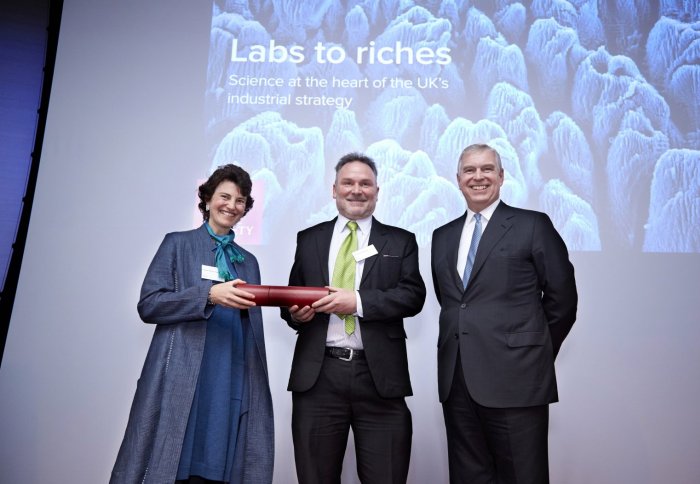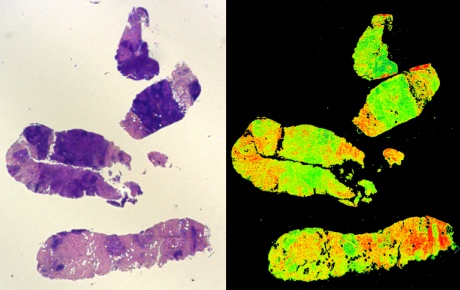Technology that could detect cancer more accurately wins Innovation Award

Professor Chris Phillips (centre) and his collaborator Professor Rebecca Fitzgerald (left) receiving their award
A system that automatically classifies cancer biopsies, developed by an Imperial physicist, has won a Royal Society prize to help it get to market.
The award of £246,552 is for scientists to develop a proven novel concept or prototype into a near-market ready product.
Digistain, developed by Professor Chris Phillips in the Department of Physics at Imperial, is a new way to assess the severity of cancer from tumour biopsies.
Currently, when a biopsy is taken, it is stained with two vegetable dyes and examined under a microscope. A doctor then makes an assessment of the stage of the cancer.
This process has been in place for decades, but is highly subjective, and previous studies have shown that the diagnosis can vary widely between different doctors looking at the same sample.

Breast cancer tissue stained with traditional vegetable dyes (L) and the same tissue imaged with Digistain (R)
Now, Professor Phillips has invented a method of analysing the samples using mid-infrared light, producing images that can be automatically analysed by a computer program and more accurately and reliably detect the severity of the cancer.
Previously, Professor Phillips demonstrated how the technique can be reliable on breast cancer tissue, and is now teaming up with Professor Rebecca Fitzgerald at the MRC Cancer Unit, University of Cambridge, to target oesophageal cancer.
Earlier diagnosis
Oesophageal cancer is relatively rare, but it has increased six-fold in the last thirty years, and has only a 15 per cent survival rate for more than five years. Part of the reason for this is that people often do not know they have it until they have trouble swallowing, when the disease is already quite advanced.
This award is invaluable for helping us in crossing the ‘valley of death’
– Professor Chris Phillips
It can be diagnosed by an endoscope (a tube with a camera) in the throat, but that is a costly and invasive process. Professor Fitzgerald invented Cytosponge, a material that can be sent down the throat to collect samples of the lining.
The sponge is then sent to a lab and imaged with Digistain, allowing cancer to be detected sooner. In the early stages, the bad tissue can be burned away to halt the development of disease.
The team hope this could lead to a national screening program similar to the smear test, particularly for those with persistent heartburn, which is a risk factor. The technology could be available in clinics within ten years.
Science and innovation
Professor Phillips said the award will help him translate his research into a real commercial product: “This award is invaluable for helping us in crossing the ‘valley of death’. Firstly the freedom that we can spend it makes it a really effective lubricant in a complex enterprise like this that involves many parties; secondly that fact that constitutes the imprimatur of some of the nation’s best scientific entrepreneurs really impresses investors!”
The prize, along with eight others for innovative projects at different stages, were presented at a Labs to Riches event last night (30 March). The evening brought together leading scientists, engineers, industrialists and policymakers to celebrate the achievements of some of the UK’s most innovative researchers. The event theme focused on the role of science in the UK’s industrial strategy and contribution to economic growth.
Commenting on the awards, Dr Hermann Hauser, science entrepreneur and co-chair of the Royal Society’s Science, Industry and Translation Committee, said: “These awards support some of the very best, innovative researchers in UK universities to increase their chances of entrepreneurial success.
"The process of translating research from academia into commercially viable products can be challenging and we are proud to help bridge the journey for nine researchers this year.”
Article supporters
Article text (excluding photos or graphics) © Imperial College London.
Photos and graphics subject to third party copyright used with permission or © Imperial College London.
Reporter
Hayley Dunning
Communications Division